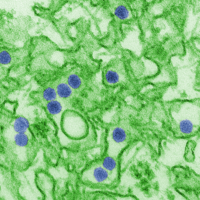
Photo from wikipedia
BACKGROUND Zika virus is a newly recognized human teratogen; monitoring its impact on the birth prevalence of microcephaly and other adverse pregnancy outcomes will continue to be an urgent need… Click to show full abstract
BACKGROUND Zika virus is a newly recognized human teratogen; monitoring its impact on the birth prevalence of microcephaly and other adverse pregnancy outcomes will continue to be an urgent need in the United States and worldwide. METHODS When the Centers for Disease Control and Prevention (CDC) activated the Emergency Operations Center for the Zika virus outbreak response in January of 2016, public health leadership recognized that a joint, coordinated effort was required between activities focused on the effects of the infection among pregnant women and those focused on birth defects in fetuses and infants. Before the introduction of Zika virus in the Americas, population-based birth defects surveillance occurred independently of pregnancy surveillance activities. RESULTS The coordination of pregnancy surveillance and birth defects surveillance implemented through the CDC Zika virus response represents a paradigm shift. CONCLUSION Coordination of these surveillance systems provides an opportunity to capture information from both a prospective and retrospective approach. This relatively modest investment in the public health infrastructure can continue to protect pregnant women and their infants during the ongoing response to Zika virus and in the next emergent threat to maternal and child health. Birth Defects Research 109:372-378, 2017. © 2017 Wiley Periodicals, Inc.
Journal Title: Birth defects research
Year Published: 2017
Link to full text (if available)
Share on Social Media: Sign Up to like & get
recommendations!